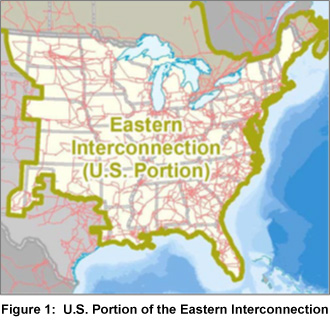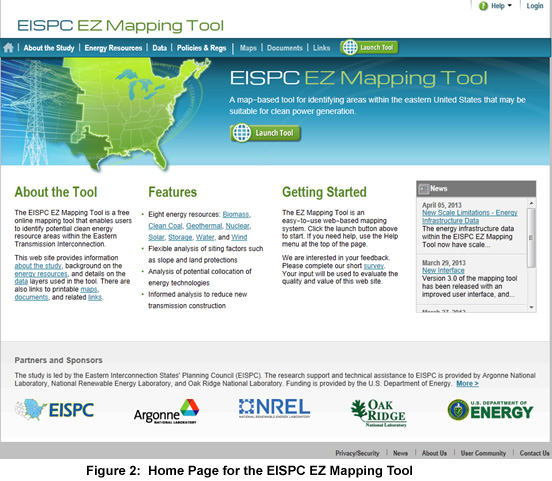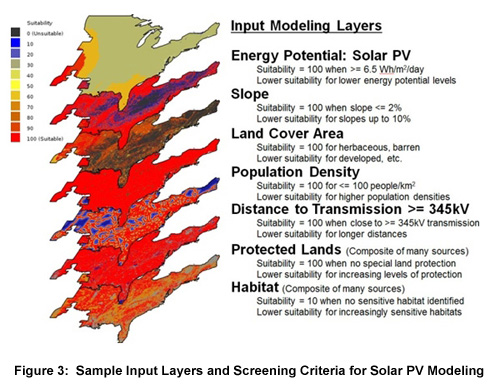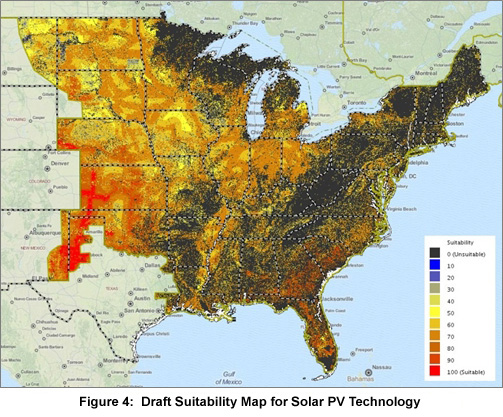| Center for Energy, Environmental, and Economic Systems Analysis (CEEESA) |  |
Research Areas:
Energy, Environment, and
Economics
National and Homeland
Security
Infrastructure Assurance
Emergency Preparedness
Social Dynamics
Policy Analysis
Core Capabilities:
Systems Analysis
Modeling, Simulation, and
Visualization
Complex Adaptive Systems
Decision Support and Risk
Management
Information Sciences

|
|
|
Argonne National Laboratory's Decision and Information Sciences (DIS) and Environmental Science (EVS) Divisions are leading the effort by three national laboratories to provide support to the Eastern Interconnection States Planning Council (EISPC) in conducting the Energy Zones Study for the Eastern Interconnection. EISPC is an organization of energy planning and regulatory offices from 39 states in the eastern part of the United States, the District of Columbia, the City of New Orleans, and 8 provinces in Canada. The laboratory project team consists of Argonne, the National Renewable Energy Laboratory (NREL), and Oak Ridge National Laboratory (ORNL).
Objectives
The purpose of the project is to develop a methodology and a Web-based mapping tool (EISPC Energy Zones Mapping Tool) that will enable EISPC stakeholders to identify areas within the U.S. portion of the Eastern Interconnection (Figure 1) that are suitable for developing clean (low- or no-carbon) energy resources for electricity generation. Rather than identifying specific energy zones, the objective of the project is to provide EISPC and other stakeholders with an interactive, Web-based decision support system to assist them in identifying areas with a high density of clean energy resources that may potentially be designated as Clean Energy Zones (the eventual designation of Clean Energy Zones will be left to the jurisdictional authorities in each state). In addition to supporting the states and regions in identifying areas with resources conducive to developing clean power generation, a second objective is to enable the states to collaborate in the stakeholder generation and transmission planning process. Clean Energy Resources The Energy Zones Study includes nine types of energy resources that can provide clean (low- or no-carbon) power generation: (1) biomass, (2) clean coal technologies with carbon capture and sequestration, (3) geothermal, (4) natural gas, (5) nuclear, (6) solar (photovoltaic [PV] and concentrated solar thermal, as well as rooftop PV), (7) storage (pumped-hydro storage and compressed-air energy storage), (8) water (hydroelectric power), and (9) wind (land-based and offshore). For each of these major energy categories, the resource data and information have been compiled, reviewed, and assembled into a geographic information system (GIS) database. Because each energy resource category may support multiple technologies for electricity generation, the database comprises a total of 29 clean energy technologies. Methodological Approach The Energy Zones (EZ) Mapping Tool utilizes more than 260 GIS data layers that can be processed using various user-specified screening factors and criteria to identify areas conducive for clean energy resource development (Figure 2). The tool allows users to analyze energy resource availability data and apply various screening factors and criteria to develop customized maps depicting the suitability of different areas within the Eastern Interconnection for clean power generation. The EZ Mapping Tool database contains more than 100 environmental data layers to ensure that protected lands, imperiled species, and other environmental factors are taken into account when determining the suitability of certain areas for clean energy resource development. Figure 3 shows the default input mapping layers and criteria for the utility-scale PV model. Model results include customized maps that show areas that fit user-specified screening factors and criteria with different suitability levels. These suitability levels for clean energy resource development are illustrated in the maps using color-coded gradation. For example, in Figure 4, the areas with highest suitability for solar PV development are shown in red, while those with the lowest suitability are shown in black.
Argonne's EVS Division is leading the GIS and Web development effort for the EZ Mapping Tool. The technical approach includes the use of open-source programming libraries for all Web development; highly scalable cloud architecture for the server; a form-based administrative interface for maintaining the content; and flexible user interfaces for the GIS map layer library, models, and reports. The EZ Mapping Tool was publicly launched at the end of March 2013 and is already being accessed by federal and state energy planners, non-governmental organizations, grid operators, energy industry professionals, and researchers. Interested stakeholders are invited to register for the EISPC EZ Mapping Tool at http://eispctools.anl.gov. EZ Study Team Argonne leads the analytical work on the Energy Zones Study in collaboration with NREL and ORNL and in partnership with the EISPC and its stakeholders. The project team also coordinates the work and collaborates with several EISPC subcontractors, such as the Clean Energy State Alliance and Navigant Consulting. Significant collaboration and support to the project are provided by numerous non-governmental organizations, such as NatureServe, The Conservation Fund, the National Audubon Society, The Wilderness Society, and others. Commercial information licensed for the project includes data from Bentek Energy/Platts, AWS Truepower, and NatureServe. Funding for the project is provided by the U.S. Department of Energy, Office of Electricity Delivery and Energy Reliability. |
|
|
For more information, contact: |
|
|
||||||||||||
| U.S. Department of Energy Office of Science | UChicago Argonne LLC |
| Privacy & Security Notice | Contact Us | Search |



